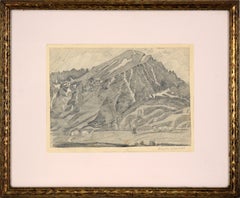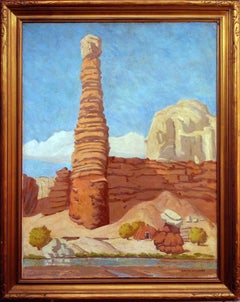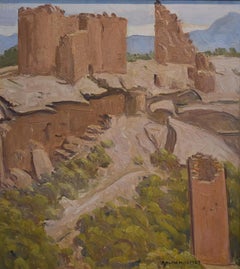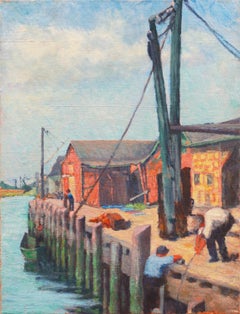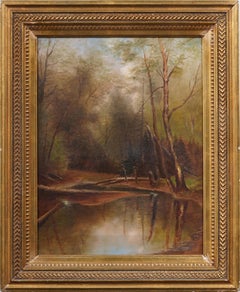Signed, verso, in Cyrillic, 'Leontev V.E.' for Valentin Nikolaevich Leontiev (Russian, 1912-1984) and inscribed, 'City of Yarolsavl on the River Volga. Painter, Leontev V.E. Showing Ilaskaya Church, symbol of 17th Century architecture'. Painted circa 1965. Accompanied by old framing label bearing title, 'Church of the Prophet Elijah'.
Displayed in a burnished gilt-wood frame; framed dimensions: 21.5 H x 17.5 W x 1.5 D inches
Valentin Nikolaevich Leontiev; painter, teacher. Honored Worker of Culture of the USSR (1973).
Member of the Great Patriotic War of 1941-1945. He was awarded a commemorative medal. Medal "For Valiant Labor. In commemoration of the 100th anniversary of the birth of V.I. Lenin. Member of the Union of Artists of Russia (1947). Chairman of the Board of the Yaroslavl Union of Artists (1961-1964), member of the board until 1982.
In 1931 he graduated from the Yaroslavl Art and Pedagogical College (teacher - S.F. Shitov) and continued his studies in Leningrad (teachers - I.I. Brodsky, A.A. Osmerkin, B.V. Ioganson). He was a Stalin scholarship holder. In 1941, from the 6th graduation course of the institute at the Academy of Arts, he volunteered for the front. Participated in battles near Narva and Kingisepp (North-Western Front). When the regiment left the encirclement, he was captured, in April 1945 he was liberated by the allied forces in Germany on the river. Elbe. After his release, he fought on the 2nd Belorussian Front, participated in the battles near Königsberg.
In 1947 he graduated from the Leningrad Institute of Painting, Sculpture and Architecture. I.E. Repin of the Academy of Arts of the USSR, having defending his thesis - the monumental composition "Meeting of the Winners". After graduation, he taught at the Cheboksary (Chuvash ASSR) art school (1949-1951). In 1951 he returned to Yaroslavl and for 32 years (1951-1983) taught at an art school. There are many well-known artists among the students of Valentin Nikolaevich Leontiev.
In addition to many landscapes ( " Morning in Yaroslavl " (1967), " Industrial motive " , " The Church of Elijah the Prophet " (1956), " Hoarfrost "(1979) and others), as well as chamber works in the genre of still life, V.N. Leontiev created several significant thematic canvases, including: " Weekend Morning in Cheboksary " (1950 - Chuvash State Art Museum), " Building Communism " (1951, YAHM).
Participant of regional, interregional, zonal, regional, republican and all-Union exhibitions. Personal exhibitions in Yaroslavl: 1972, 1983 and 1997. V.N. Leontiev participated in the work of several congresses of the Union of Artists of the RSFSR and the Union of Artists of the USSR, in the formation of regional exhibitions. Works by V.N. Leontiev are kept in the museum collections of Yaroslavl, in Russian and foreign private collections.
From the introductory article to the exhibition catalog "Valentin Nikolaevich Leontiev and his students ” , 2008 Art critic Olga Shikhanova.
He was loved by both students and fellow artists. Many even now remember with a smile many funny stories associated with the name of Valentin Nikolaevich Leontiev, one of the most significant painters of Yaroslavl. Many are still grateful to him for the lessons of mastery, for patience and tolerance, for a sincere interest in their first, albeit timid, steps in art and for a personal example of passion for creativity.
A native Yaroslavl, Leontiev was born on February 5, 1912. His father was a wagon coupler on the railroad and died when his son was 7 years old. Mother Alexandra Nikolaevna worked all her life as a painter at one of the oldest paint and varnish enterprises in the country - the Victory of Workers plant.
An inquisitive and active boy at the age of ten joined the first pioneer detachment on Krasny Perekop and from that time became addicted to drawing. Valentin received his initial art diploma in the then popular working studios of fine arts, and in the Yaroslavl Art School, where he entered in 1928, his teachers were wonderful teachers Sergei Fedorovich Shitov and Pyotr Nikolaevich Shadrikov, who stood at the origins of the Yaroslavl art school.
In 1931, after defending his diploma, Leontiev received a referral to the Victory of Workers factory, where he conscientiously performed the usual work for a factory artist: he wrote slogans, drew wall newspapers, designed stands with the results of socialist competitions. Such work could not give real creative satisfaction to a person with his pictorial possibilities. In 1933, Valentin first entered the preparatory classes of the All-Russian Academy of Arts, and in 1935 became a student.
Art and creative work carried away, and the names of the teachers I. Brodsky, A. Osmyorkin, B. Ioganson, E. Serov, R. Frentz, A. Zaitsev, who had already entered the history of Russian art, turned their heads. In 1940, for excellent progress, Vadentin was awarded the highest student award - a state scholarship. Even then, Leontiev's leadership qualities appeared, and in 1938 he was elected a member of the Student Youth Council under the Central Committee of the Komsomol.
For the diploma, he painted a large-scale painting "Children on the Volga" (headed by A.I. Savinov). These few Leningrad years were the happiest in Leontiev's life. After all, it was there, within the walls of the Academy, that he met a friend for life - Evsey Moiseenko, and there he met his only love, Tanya Edelson. The wedding was played in a student hostel in January 1941. But June 1941, like many young people of his generation, dramatically changed the life that had begun so wonderfully. The terrible word "War!"
Leontiev and Moiseenko, academic scholarship holders, on whom great hopes were placed, were completely exempted from military service, but both made the only choice possible for them at that time: instead of defending their diploma, in July 1941 they signed up as volunteers in the people's militia. On a memorable day, a large group of students gathered at the Academy - future historians, artists, musicians - all of whom the slogan "Leningrad is in danger!" also did not leave indifferent. From there, everyone went first to the militia, and then to the front. Private of the 4th Volunteer Division, Leontiev participated in the construction of defensive fortifications around Leningrad. The militias dug the ground, constructing anti-tank ditches and pillboxes. After heavy fighting near Narva and Koenigsberg, some colonel undertook to take them out of the encirclement. And so it happened that led untrained soldiers directly to the Germans. So Leontiev was captured, and soon ended up in Germany. Repeated attempts to escape each time ended in raids and brutal reprisals. Finally, he was given as free slaves to a German farm, where he stayed until the arrival of the Red Army.
It was a difficult time for Leontiev's wife, Tatyana: in November 1941, their son Vladik was born in Anapa. She survived nine months of occupation and the inability to learn anything about the fate of her husband.
Freed from captivity, Leontiev served in the 128th separate communications battalion of the 24th Army of the Belorussian Front until October 1945, and all this time he tried to contact his relatives. He was considered missing. Finally, Valentin was reunited with his family, and then a wonderful portrait of his son appeared, which the artist painted on the same day - “Vladik. Meeting with my son. Leontiev's graduation work was lost during the war years. Having written under the guidance of B.V. Ioganson and V.A. Serov's new large painting "Meeting of the Winners" (280x350), Valentin in 1947 defended his diploma. The high
commission rated...
